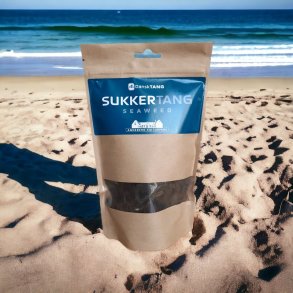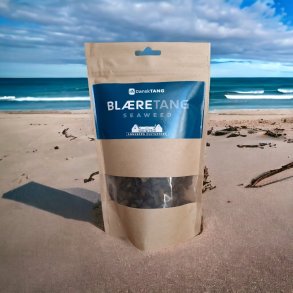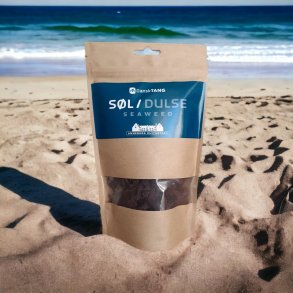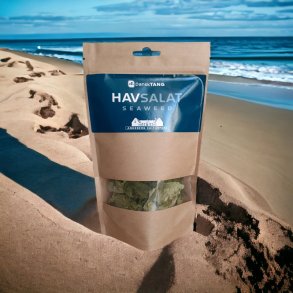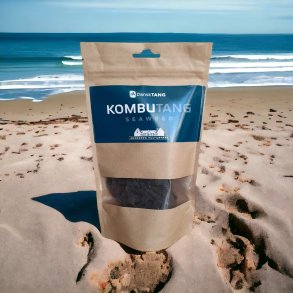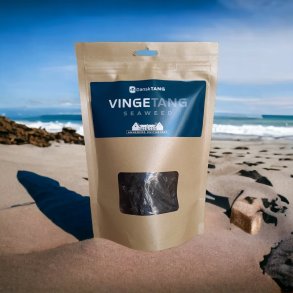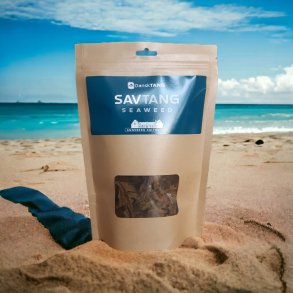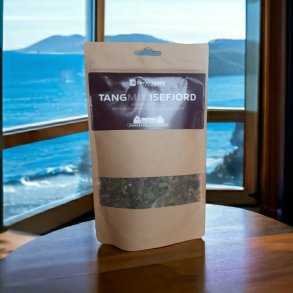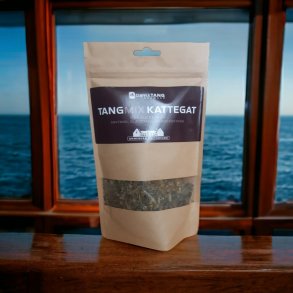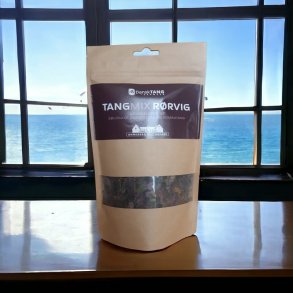Danish Seaweed
Danish Seaweed is a sustainable resource
which is harvested above the growth zone so that it can quickly shoot again afterwards. In this way, the seaweed both contributes to removing nitrogen from the sea, while at the same time creating a nutritious food for your everyday life.
.jpg)
Back in 2015-2016, NOMA, which has been named the world's best restaurant many times, had been abroad to seek inspiration. They returned home and decided to build a brand new restaurant and in this connection Dansk Tang began supplying seaweed to the restaurant NOMA 2.0.
At that time, Dansk Tang had only been in business for 1 1/2 years and was traveling around Denmark selling salt, pesto, oil and dried products. The decision to deliver to NOMA was not difficult – who wouldn't. But it also meant a total upheaval of what they were doing. Many meetings and good support from the board led to the fact that to this day they supply both fresh and dried seaweed to all top restaurants, as well as restaurants, cafes and catering companies. In November 2021, they entered into a partnership with Fiskerikajen, which supplies fish to many of the same customers. It was a good match as the focus on seaweed increased, especially due to the increasing focus on the climate. Today, Dansk Tang offers as many as 22 different fresh species of seaweed throughout the year. Dansk Tang has modestly introduced and trained many chefs in working with sea vegetables over the years.
In 2004, the Nordic Kitchen Manifesto was created and formulated. Six points were drawn up: purity, seasons, ethics, health, sustainability and quality. The Manifesto for New Nordic Food has an innovative approach to traditional foods with a strong focus on health and an ethical production philosophy. Put another way, the food culture in the Nordics must be known, admired and loved worldwide for its high ambitions, delicious meals, the ability to combine good taste and health, its generosity and responsibility in relation to the great challenges associated with production and consumption of food. A number of the Nordics' leading chefs signed the manifesto in 2004, including Erwin Lauterbach and René Redzepi in Denmark.
Danish seaweed is sold today as dried seaweed: Sugar seaweed, Kombutang, Bære seaweed, Sea lettuce, Wing seaweed, Irish moss and Søl/dulse.
And granulates of seaweed mix:
Kattegat - Saw tang, bladder tang & sugar tang
Isefjord - Søl/dulse, seaweed and sea lettuce
Rørvig – Søl/Dulse, sugar tongs and kombutan
How often do you eat seaweed yourself? There is no doubt that we are only just beginning to see the possibilities in seaweed. Through sushi, many have become familiar with seaweed, which is the green plant that is used in various versions at sushi restaurants. The green seaweed salad is also often mentioned when people say they have tasted seaweed, but let it be said straight away, it is not the seaweed itself that you are tasting, it is the marinade it is in. If it was cabbage or leaves, they would taste the same, so it doesn't quite count towards the "seaweed account". Check if the goods declaration. However, there is seaweed in the product - seaweed of the wakame type.
The history and early human use of seaweed
As seaweed decomposes quickly, it is difficult to find clear archaeological evidence that humans have used seaweed as food in the past. But it seems natural, as humans have always had an interest in finding food in the form of fish and shellfish in the water.
In general, what has been written about seaweed in history is limited, but we are really happy that Ole G. Mouritsen has given permission to use passages from his book "Tang - Vegetables from the sea"
In recent years, there has been a lot of talk about the paleo diet, also known as the Stone Age diet. Archaeologist and botanist Sabine Karg, who is an external lecturer at the Saxo Institute at the University of Copenhagen, has specialized in archaeobotany, as she told in an interview to Videnskab.dk in 2012 about the findings in archaeological excavations:
"Carbohydrates have been part of the diet. Traces of both roots and seeds from various aquatic plants and wild grass species have been found at flooded settlements from the Hunter Stone Age.'
"What you find in the archaeological excavations depends both on the preservation conditions and on how the food was prepared at the time. For us, the conditions are particularly good on flooded settlements, where organic material is well preserved, and in fire layers or hearths where you find burnt plant remains,' says Sabine Karg and gives an example:
"For example, we have found seeds from wild grass species and aquatic plants as well as roots that were part of the hunters' diet. Especially when you weren't lucky on the hunt, you had to go out and collect and dig up roots.'
Production of seaweed salt
It was also quickly discovered that salt could be developed from seaweed - in fact, salt has been produced all the way back to ancient times. Ole G. Mourtisen naturally also mentions this in his book:
Burning seaweed produces salty seaweed ash, as does slurping in seawater and subsequently
evaporation leads to black salt containing some of the seaweed's combustion products. Salt production from
seaweed has been widespread in many coastal areas in the Nordics and has been particularly important in periods of scarcity
imported white sea salt, especially for salting fresh food. Throughout the Middle Ages and in Norway
right up to the 20th century, seaweed, especially bladder seaweed and eelgrass, has been used as fertilizer on the fields, often
together with manure. The seaweed has a good content of phosphorus, nitrogen and especially potassium, but
the salt content has been less desirable for some field crops. In the Nordics too, there are periods
used seaweed to produce soda, for example on Hirsholmene. However, soda production was in several places
based on beach plants, for example, there is even an herb, sodawort, whose name reflects this utilization.
During archaeological excavations in Tårnby in 1993-94 before the construction of the Øresund connection, results were found that indicate that Tårnby farmers in the Middle Ages used seaweed on a large scale, to which they had easy access. The seaweed was used for the roofs of the farms and as insulation. Soap and important salt have also been extracted from the seaweed. Salt was used to preserve fish and meat. The meat probably did not taste good after being salted for a long time, so in the Middle Ages the food was heavily seasoned, and among other things, coriander was used. On Amager, seaweed has been used for several centuries as insulation material for the suits, and then reused as fertilizer. Each town had its own piece of seaweed, and there were fixed rules for when and how the seaweed could be collected. In 1850, 10 farm and householders in Ullerup and Viberup applied to the Danish Landhusholdningsselskab, which was responsible for Kongelund, for permission to drive through the forest to the beach for seaweed. The application emphasized the importance of seaweed for Amagerbrug, both as a fertilizer, as we are far from Copenhagen (where the latrine was obtained), and for preserving vegetables in winter. In these situations, pliers were largely indispensable.
The Furgin adventure in the 1950s in Denmark
A failed experiment in a kitchen created a seaweed adventure in Denmark in the late 1950s.
It was a man named Freddy Nielsen who had received a tip that alginic acid could be extracted from ordinary seaweed. It's actually a pretty interesting story, because it's the story of an idea, a failed attempt that ends up as a sensational invention.
Back in 1942, Freddy Nielsen stood in his kitchen cooking Kattegat seaweed into a brownish soup, which immediately turned into a particularly unappetizing soup. So initially the project to extract alginic acid came to nothing.
Frederik had gotten hold of a large pile of bladderwrack through some fishermen, and had then set to work in the kitchen, and although Freddy had mixed the kelp with various chemicals and boiled it, the desired result did not appear (Freddy was originally trained as a hairdresser, but had then thrown poring over a lot of chemistry books) But when he discovered that the seaweed continued to develop heat, he became curious anyway and investigated the seaweed more closely. Between the bladderwort, he found a red alga that was called fork kelp (today fork kelp). He believed that it must be the one to blame for the heat development. He sorted out the fork and boiled it in a saucepan, and left it for a while. The result was a reddish-brown, slimy mass – another failed attempt. So Frederik put the saucepan on the windowsill, thinking another failed attempt, or almost, because the next day, when his wife had to use the saucepan and Freddy wanted to clean it, he discovered that during the night the red-brownish soup had become to a solid gel. So without knowing it, he had produced the coveted substance, agar.
Freddy achieves several accolades for his discoveries. In 1945 the Polytechnic Institute nominated him for the Faco Prize and in 1946 he received the Tuborg Prize. But the competition from Asia was great and even though he struggled to get customers, e.g. by traveling the world, you never quite manage to achieve the great success. When Freddy Nielsen died in 1950, his colleague took over the work of rationalizing operations and production. When the colleague carries out some analyses, he finds out that the substance produced on the basis of the fork tongs was not agar at all! It did have some similarities, but in reality it was furgin. It had a number of special properties which made it extremely suitable for a number of purposes where you would not think of using agar. At the time, production was quite extensive in Denmark. Litex which was located in Copenhagen, Skandinavisk Agar Industri" in Vejle and "Algadan" in Frederikshavn, where Freddy Nielsen's colleague was manager, now all worked to extract starch from seaweed.
Locally, there was a branch of the company Litex, it was located in Havnsø (the branch was established in 1954). Here, in the Tangkrogen, seaweed was sorted for the department in Copenhagen.
The amount of fork kelp collected in the Kattegat by trawling the kelp was large. It was not unusual for the ships to pick up 100 tons a day. In 1958, 25,000 tonnes of fork tang were trawled in the Kattegat.
The furgin powder dissolves easily in cold or lukewarm water, and it has seven times the gel strength of house air.
In 1958, only 5% of Danish furgin production was sold at home, the rest was exported. Thus ends the story of Freddy Nielsen
Today, the company CP Kelco exists in Lille Skensved, they work to extract seaweed starch. This product is also known as E-406 (Agar) and E-407 (Carrageenan) and this is added to toothpaste, cocoa milk and whipped cream, among other things.







